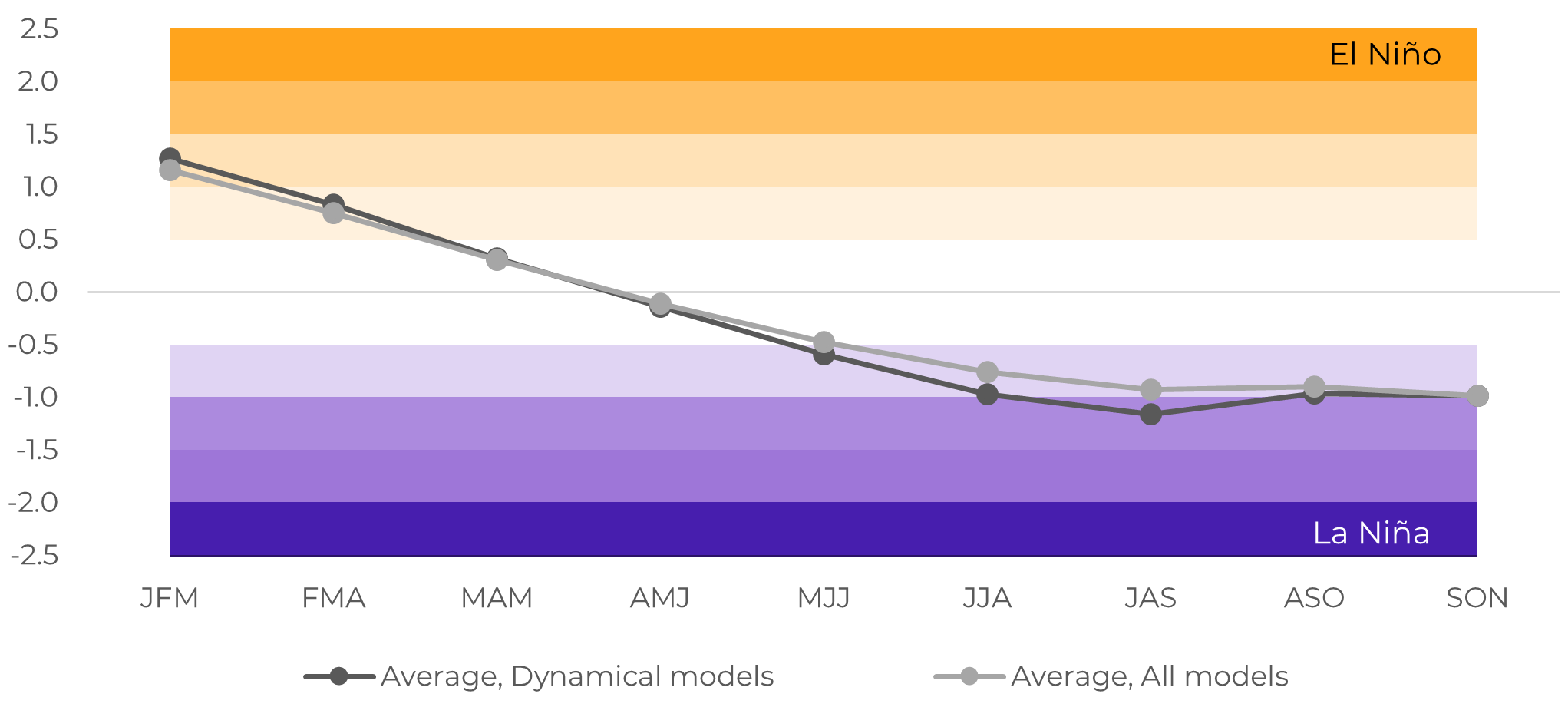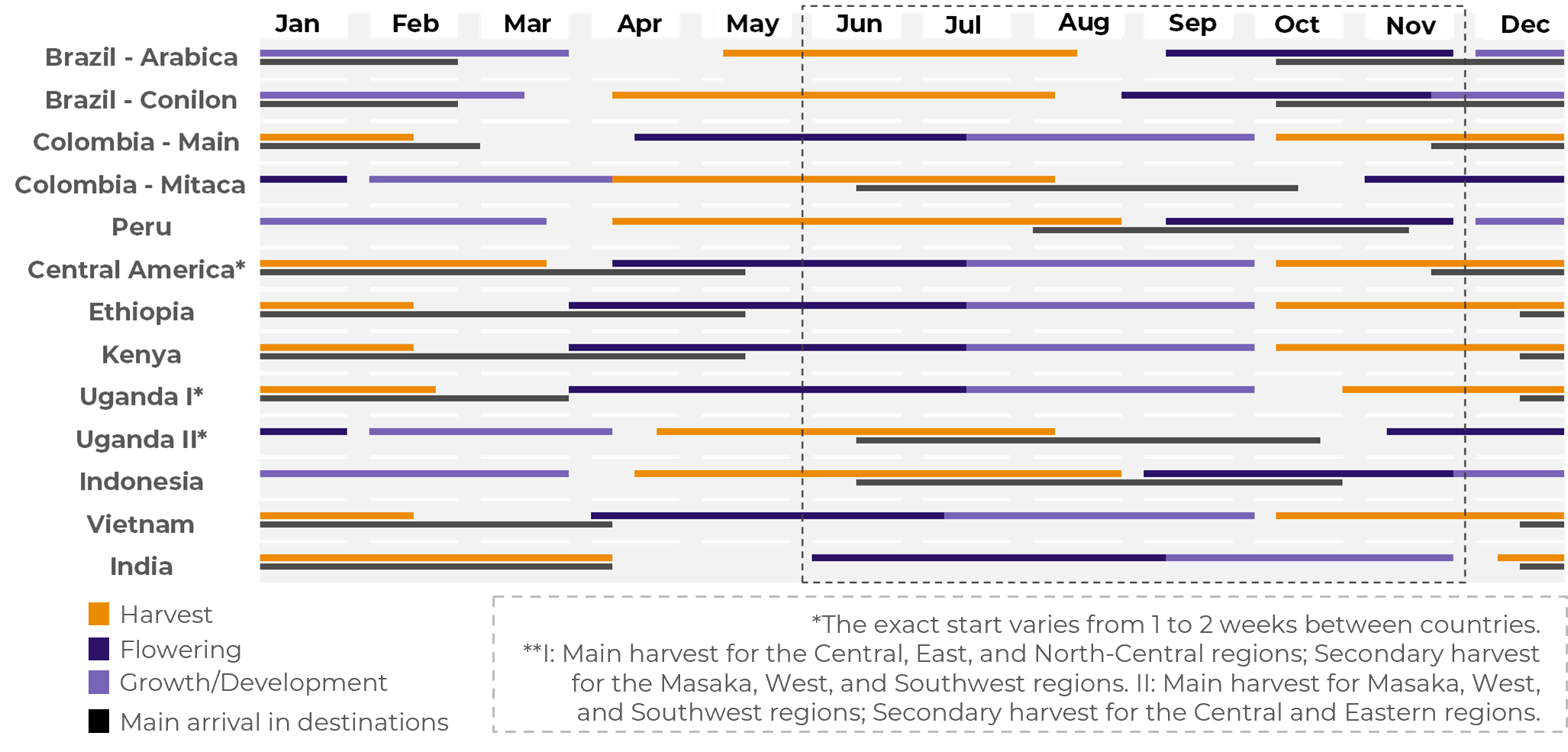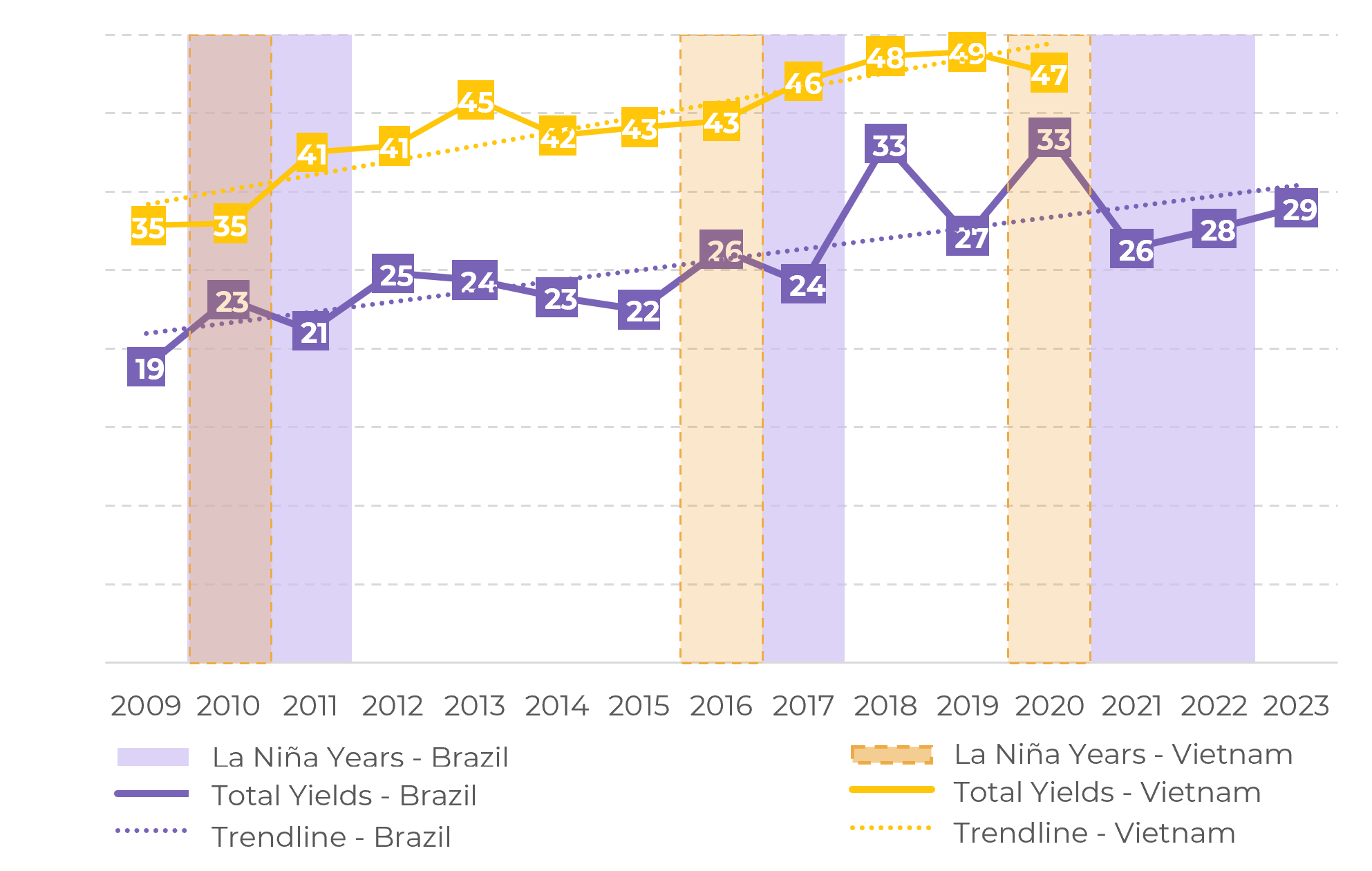
Mar 15
/
Natália Gandolphi
Coffee Weekly Report - 2024 03 15
Back to main blog page
- The La Niña event is expected to impact coffee-producing regions globally once again, with the event likely to become active towards the end of the second quarter, according to CPC’s last update.
- In Brazil's Southeast, lower temperatures and increased frost risks threaten coffee crops. Indonesia may experience delayed or disrupted harvests due to heavier rains, especially in Sumatra.
- Vietnam faces negative temperature anomalies during the phenomenon, but its impact on yields remains uncertain. In Colombia and Guatemala, heavier rains may damage trees or increase disease susceptibility. Additionally, Central American countries face heightened risks of tropical storms and hurricanes during La Niña episodes.
- While historical data suggests correlations between the phenomenon and yield fluctuations, attributing yield reductions solely to La Niña is challenging due to other influencing factors. Overall, the event presents diverse risks across coffee-producing regions, underscoring the need for careful monitoring and adaptation strategies within the industry.
La Niña likelihood increases – what are the risks?
Last Thursday (14), the Climate Prediction Center in the United States released the latest update regarding the possibility of La Niña developing in the second quarter.
The upcoming La Niña event is expected to persist into the Southern Hemisphere winter, impacting various coffee-producing regions globally. Brazil's coffee crop, particularly in the Southeast, faces risks of lower temperatures and increased frost occurrences due to the phenomenon's influence. Historical data shows that the event during vegetative development phases correlates with decreased yields, such as the 21/22 season witnessing a 19% drop compared to the previous cycle.
In recent years, the phenomenon has been either active or on watch during the June-August quarter, coinciding with the vegetative development of subsequent crops in Brazil. During these periods, three out of four occurrences saw decreased yields, indicating a potential link between La Niña and production declines. Notably, the 21/22 season experienced a significant yield reduction attributed to the event’s influence.
In Indonesia, where coffee harvest spans from April to September, the phenomenon may bring heavier rains, particularly affecting regions like Sumatra. This increased precipitation could disrupt or delay the harvest, as observed in past occurrences where yield reductions were not solely attributed to La Niña but also to other one-off conditions during development.
Figure 1: ENSO Status (ONI Index)

Source: IRI
Figure 2: Crop Calendar

Source: hEDGEpoint
Vietnam experiences negative temperature anomalies during La Niña, potentially impacting coffee yields. However, historical data suggests that La Niña's influence on yields remains unclear, with no significant disruption observed in past occurrences. Despite experiencing negative temperature anomalies, Vietnam's yields have either remained unchanged or increased in three out of the four occurrences, indicating a limited impact of La Niña on production – in the year-over-year comparison, which depends heavily on one-off factors. Otherwise, La Niña has capped growth against the trendline (total potential), which demands attention.
In contrast, Colombia and Guatemala anticipate heavier rains during La Niña, which could lead to tree damage or increased disease susceptibility. Although increased precipitation during La Niña might seem beneficial for crop development, excessive rainfall, reaching up to 600% of normal levels, poses risks to coffee trees and creates an environment conducive to diseases. Additionally, Central American countries face higher risks of tropical storms and hurricanes during La Niña episodes, further impacting crop yields.
Figure 3: Coffee Yields – Brazil and Vietnam (bags/ha)

Source: USDA, Conab, IRI
In Summary
Overall, the La Niña event poses challenges for coffee producers worldwide, from damages in Brazil to delayed harvests in Indonesia and heightened precipitation in Colombia and Guatemala. While the market closely monitors La Niña's effects on coffee production, accurately predicting its impact remains challenging due to the interplay of various factors influencing crop yields – however, based on records from recent years, the phenomenon could present itself as a bullish factor, if it becomes active during key moments of development from the second quarter onwards.
Weekly Report — Coffee
Written by Natália Gandolphi
natalia.gandolphi@hedgepointglobal.com
natalia.gandolphi@hedgepointglobal.com
Reviewed by Pedro Schicchi
pedro.schicchi@hedgepointglobal.com
www.hedgepointglobal.com
Disclaimer
This document has been prepared by hEDGEpoint Global Markets LLC and its affiliates ("HPGM") exclusively for informational and instructional purposes, without the purpose of creating obligations or commitments with third parties, and is not intended to promote an offer, or solicitation of an offer, to sell or buy any securities or investment products. HPGM and its associates expressly disclaim any use of the information contained herein that may result in direct or indirect damage of any kind. If you have any questions that are not resolved in the first instance of contact with the client (client.services@hedgepointglobal.com), please contact our internal ombudsman channel (ouvidoria@hedgepointglobal.com) or 0800-878-8408 (for clients in Brazil only).
Contact us
hedgepointhub.support@hedgepointglobal.com
ouvidoria@hedgepointglobal.com
Funchal Street, 418, 18º floor - Vila Olímpia São Paulo, SP, Brasil
This page has been prepared by Hedgepoint Schweiz AG and its affiliates (“Hedgepoint”) solely for informational and instructional purposes, without the purpose of instituting obligations or commitments to third parties, nor is it intended to promote an offer, or solicitation of an offer of sale or purchase relating to any securities, commodities interests or investment products. Hedgepoint and its associates expressly disclaim any use of the information contained herein that directly or indirectly result in damages or damages of any kind. Information is obtained from sources which we believe to be reliable, but we do not warrant or guarantee the timeliness or accuracy of this information. The trading of commodities interests such as futures, options, and swaps involves substantial risk of loss and may not be suitable for all investors. You should carefully consider wither such trading is suitable for you in light of your financial condition. Past performance is not necessarily indicative of future results. Customers should rely on their own independent judgement and/or advisors before entering in any transaction.Hedgepoint does not provide legal, tax or accounting advice and you are responsible for seeking any such advice separately.Hedgepoint Schweiz AG is organized, incorporated, and existing under the laws of Switzerland, is filiated to ARIF, the Association Romande des Intermédiaires Financiers, which is a FINMA-authorized Self-Regulatory Organization. Hedgepoint Commodities LLC is organized, incorporated, and existing under the laws of the USA, and is authorized and regulated by the Commodity Futures Trading Commission (CFTC) and a member of the National Futures Association (NFA) to act as an Introducing Broker and Commodity Trading Advisor. HedgePoint Global Markets Limited is Regulated by the Dubai Financial Services Authority. The content is directed at Professional Clients and not Retail Clients. Hedgepoint Global Markets PTE. Ltd is organized, incorporated, and existing under the laws of Singapore, exempted from obtaining a financial services license as per the Second Schedule of the Securities and Futures (Licensing and Conduct of Business) Act, by the Monetary Authority of Singapore (MAS). Hedgepoint Global Markets DTVM Ltda. is authorized and regulated in Brazil by the Central Bank of Brazil (BCB) and the Brazilian Securities Commission (CVM). Hedgepoint Serviços Ltda. is organized, incorporated, and existing under the laws of Brazil. Hedgepoint Global Markets S.A. is organized, incorporated, and existing under the laws of Uruguay. In case of questions not resolved by the first instance of customer contact (client.services@Hedgepointglobal.com), please contact internal ombudsman channel (ombudsman@hedgepointglobal.com – global or ouvidoria@hedgepointglobal.com – Brazil only) or call 0800-8788408 (Brazil only).Integrity, ethics, and transparency are values that guide our culture. To further strengthen our practices, Hedgepoint has a whistleblower channel for employees and third-parties by e-mail ethicline@hedgepointglobal.com or forms Ethic Line – Hedgepoint Global Markets.Security note: All contacts with customers and partners are conducted exclusively through our domain @hedgepointglobal.com. Do not accept any information, bills, statements or requests from different domains and pay special attention to any variations in letters or spelling, as they may indicate a fraudulent situation.“HedgePoint” and the “HedgePoint” logo are marks for the exclusive use of HedgePoint and/or its affiliates. Use or reproduction is prohibited, unless expressly authorized by HedgePoint. Furthermore, the use of any other marks in this document has been authorized for identification purposes only. It does not, therefore, imply any rights of HedgePoint in these marks or imply endorsement, association or seal by the owners of these marks with HedgePoint or its affiliates.

